Somewhere in Turkey (1918)
Starring: Harold Lloyd, Bebe Daniels, William Blaisdell, and Harry Pollard
Director: Alf Goulding
Rating: Five of Ten Stars
An explorer (Lloyd) and a beautiful castaway (Daniels) fall in love while imprisoned by an idol-worshipping sultan (Blaisdell).
"Somewhere in Turkey" may be one of those films that the passage of time has left behind... or maybe it's just not that good and even audiences in 1918 might have felt a little disappointed. While it's probably both, I think it's more of the latter than the former.
First, while the film has many strong slapstick moments (several involving literal slapping), most of the comedic routines are stretched to the point they stop being funny and start being repetitive; this is not a good thing for any film, but it's Very Bad when we're talking about something with a running-time of 10 minutes. Second, the story is sloppily constructed with Harry Pollard's character just vanishing about 2/3rds of the way through... and Lloyd's character doesn't seem to give him a second thought as he rides off with his new lady-friend. It's actually unusual for these comedies to leave such a huge element unresolved. (Of course, since the version I viewed--which is embedded below--is 10 minutes in length, and various sources report that it's 12 minutes long, so maybe Pollard's fate is explained in that missing footage.)
As for the film being left behind by the passage of time, I think there are some things that modern viewers will find distracting that might not have bothered audiences a century ago. For example, there's an executioner in the sultan's palace that appears in straight-up minstrel show black face instead of a black actor playing the part--something which probably shouldn't have been so far-fetched an idea, since less than two years later, black characters were being played by in films headlined by Buster Keaton, such as "Convict 13".
I have some further nitpicks about the costuming choices for this film. The characters look more Arab or Tunisian than Turkish, but that's all those are... nitpicks, and I probably wouldn't even have thought about it if not for a far bigger problem in the film:
It's a major plot point that the Sultan's court are idol-worshippers, in spite of the setting being northern Turkey and the Sultan ruling over Muslim. Even for a goofy comedy, this really stretched my disbelief, even allowing for Turkey being more "secular" in those days. Maybe audiences of 1918 didn't have the same level of cultural insights we have today--or maybe it's me that's over-educated in this matter--but more so than anything that bothered me about this film. (It's possible that the Sultan and his inner circle are secret idol-worshippers, as this is something that's hinted at in the manner Lloyd' and Pollard's characters end up in the mortal danger, but it seems more likely to me that this is just another artifact of indifferent writing. These problems could have been avoided if the film's setting had been a fictitious nation, It's a problem that could have been avoided if the location had been an imaginary one, such as in "His Royal Slyness", a 1919 film also starring Lloyd. That said, it's entirely possible that the film originally was set in a fictitious country, but was "relocated" due to Turkey being an enemy of U.S. and allies in World War I.)
For all the negativity I've just heaped on "Somewhere in Turkey", I have to say that Lloyd and Daniels are excellent together as always (once they finally get to share the screen). In fact, Daniels is front and center in all the best scenes in the film, from her melodramatic posturing when captured at the beginning of the film; to her confrontation with the Sultan; and her imprisonment and escape with Lloyd's character at the end, the scenes are all cute, funny, and to the point. In fact, I think that Daniels' presence, more than anything else, makes this film worth your taking a few minutes to check out. (And you can do so right now, since it's embedded below.)
Thursday, June 11, 2020
Wednesday, June 10, 2020
Happy birthday, Elizabeth Hurley!
Model, actress, and British tabloid-favorite Elizabeth Hurley turns 55 years today! Here are some photos of her through the years in celebration! Yeah, Bay-bee!
Picture Perfect Wednesday: It's June
For the third year in a row, we're celebrating Junes in June with photos and mini-bios. We're only doing two this year to make room for Wonder Woman Wednesdays--hence the late start!
The first June in June for 2020 is June Marlowe.
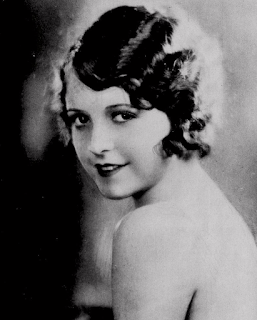 June Marlowe, born Gisela Goetten, was the oldest of six children of German immigrant parents. She began acting in silent movies straight out of high school in 1923. She maintained a busy schedule and seemed to be on a fast track to fame, but her rising star came crashing down with the introduction of sound into motion pictures.
June Marlowe, born Gisela Goetten, was the oldest of six children of German immigrant parents. She began acting in silent movies straight out of high school in 1923. She maintained a busy schedule and seemed to be on a fast track to fame, but her rising star came crashing down with the introduction of sound into motion pictures.
By 1930, she had already slipped into such obscurity that, when she had a chance encounter with a director from the Hal Roach Studios, he thought he had discovered a new talent--despite the fact she had already played significant parts in 30 films, most of them from major studios.
Today, Marlowe is mostly remembered for her role as Miss Crabtree, the cute school teacher in six "Our Gang Comedies". It was the role upon which she ended her career, retiring from acting in 1932 and marrying businessman Rodney Sprigg. She spent most of her time afterwards as a house-wife, but Marlowe also authored two children's books ("Breezy" and "Furry") late in life.
June Marlowe passed away in 1984 at the age of 80. She is buried with her parents and five siblings in the Cathedral of Our Lady of the Angels in Los Angeles.
The first June in June for 2020 is June Marlowe.
 June Marlowe, born Gisela Goetten, was the oldest of six children of German immigrant parents. She began acting in silent movies straight out of high school in 1923. She maintained a busy schedule and seemed to be on a fast track to fame, but her rising star came crashing down with the introduction of sound into motion pictures.
June Marlowe, born Gisela Goetten, was the oldest of six children of German immigrant parents. She began acting in silent movies straight out of high school in 1923. She maintained a busy schedule and seemed to be on a fast track to fame, but her rising star came crashing down with the introduction of sound into motion pictures. Today, Marlowe is mostly remembered for her role as Miss Crabtree, the cute school teacher in six "Our Gang Comedies". It was the role upon which she ended her career, retiring from acting in 1932 and marrying businessman Rodney Sprigg. She spent most of her time afterwards as a house-wife, but Marlowe also authored two children's books ("Breezy" and "Furry") late in life.
June Marlowe passed away in 1984 at the age of 80. She is buried with her parents and five siblings in the Cathedral of Our Lady of the Angels in Los Angeles.
Tuesday, June 9, 2020
You don't have to be baked to enjoy 'Doughnuts'
Doughnuts (1933)
Starring: Unknown Singers
Directors: George Rufle and Frank Sherman
Rating: Seven of Ten Stars
Tom & Jerry are doughnut-makers attending a bakers' convention along side a host of oddball competitors. They hope to impress attendees and the snooty judges who may award them a prize.
"Doughnuts" is another bit of fast-moving, nonsensical fun that's basically a seven-minute cartoon operetta. The animation is crisp and fluid, and there's not a static moment as the gags, visual puns, and health code violations flow across the screen. Highlights include a drunken sailor that looks like a cross between Popeye and Bluto; the revelation of the real reason people attend fairs; and Tom & Jerry's innovative method of making donuts. The non-stop, snappy, hilarious music also makes this one worth checking out.
One thing about this cartoon--the second-to-last entry in Van Beuren's "Tom & Jerry" series--which may offend particularly sensitive viewers out there since it seems like the writers and animators were trying to cram more ethnic stereotypes and gay jokes into seven minutes than had ever been done before. The material here is more playful than the straight-up racist stuff in "Plane Dumb" (the second "Tom & Jerry" adventure I watched, and one that I am still trying to figure out how to write a review that properly describes how it is both horribly backwards and incredibly innovative for its time), and the mockery is spread around to a broad range of people, I think the sheer volume of it may even raise an eyebrow or two among even the least uncaring and unWoke among us. See if YOU can find all the ethnic and gay jokes that are included! Watch "Doughnuts" below, then tell us how many you spotted!
Starring: Unknown Singers
Directors: George Rufle and Frank Sherman
Rating: Seven of Ten Stars
Tom & Jerry are doughnut-makers attending a bakers' convention along side a host of oddball competitors. They hope to impress attendees and the snooty judges who may award them a prize.
"Doughnuts" is another bit of fast-moving, nonsensical fun that's basically a seven-minute cartoon operetta. The animation is crisp and fluid, and there's not a static moment as the gags, visual puns, and health code violations flow across the screen. Highlights include a drunken sailor that looks like a cross between Popeye and Bluto; the revelation of the real reason people attend fairs; and Tom & Jerry's innovative method of making donuts. The non-stop, snappy, hilarious music also makes this one worth checking out.
One thing about this cartoon--the second-to-last entry in Van Beuren's "Tom & Jerry" series--which may offend particularly sensitive viewers out there since it seems like the writers and animators were trying to cram more ethnic stereotypes and gay jokes into seven minutes than had ever been done before. The material here is more playful than the straight-up racist stuff in "Plane Dumb" (the second "Tom & Jerry" adventure I watched, and one that I am still trying to figure out how to write a review that properly describes how it is both horribly backwards and incredibly innovative for its time), and the mockery is spread around to a broad range of people, I think the sheer volume of it may even raise an eyebrow or two among even the least uncaring and unWoke among us. See if YOU can find all the ethnic and gay jokes that are included! Watch "Doughnuts" below, then tell us how many you spotted!
Monday, June 8, 2020
Musical Monday with David Byrne & St. Vincent
In 2008, after meeting several times at various fundraisers, music legend David Byrne and up-and-coming singer/songwriter Annie "St. Vincent" Clark decided to collaborate on an album. Three years later, they released Love the Giant, which contained some of the best work Byrne had done in years.
The initial single for the album was "Who", which is also today's featured song and video. When I first watched this, I thought, "Jeeze... David Byrne has gotten old." Then I realized that so have I!
I hope you enjoy this very cool song, and the even cooler video! (Oh--and David Byrne may be old, but he still has The Dance Moves!)
Now (2012)
Starring: David Byrne and Annie Clark
Director: Martin de Thurah
Rating: Eight of Ten Stars
Starring: David Byrne and Annie Clark
Director: Martin de Thurah
Rating: Eight of Ten Stars
Saturday, June 6, 2020
Saturday Serial: Jenna of the Jungle
Continuing Don Hudson's "Jenna of the Jungle" (and including a random bonus jungle girl afterwards). Click on the panels for a larger image, and come back next Saturday for Part Four.
JENNA OF THE JUNGLE: PART THREE
By Don Hudson
By Don Hudson
To Be Continued...
Girls of the Jungle
 |
| By Frank Cho |
Thursday, June 4, 2020
'The Portrait' is a well-done early horror film
The Portrait (1915)
Starring: Andrey Gromov and Ivan Lazarev
Director: Wladyslaw Starewicz
Rating: Six of Ten Stars
A young artist (Gromov) buys a painting to liven up his cramped rooms. He soon comes to regret his choice, as the painting begins to change and come to life...
"The Portrait" is a rare silent horror movie that holds up to modern viewing in almost every respect. Sure, the main character is a bit over the top in his emoting, but he's not as bad as what I've seen in other films of this period. The practical effects are well done, and all the bits of business surrounding the painting coming to life are creepy and well staged. It's almost perfect.
Almost.
Unfortunately, this is one case where I desperately wanted there to be the sort of "shocking" surprise twist-ending" that's usually anything but surprising that I so often complain about in the reviews I post to Terror Titans. This film would actually have benefitted from something--almost anything--else than its actual ending. I understand why it ended the way it did... I just wish it hadn't.
But what don't you judge for yourself. Check out "The Portrait" below, and let me know if you agree with my estimation of the ending.
Starring: Andrey Gromov and Ivan Lazarev
Director: Wladyslaw Starewicz
Rating: Six of Ten Stars
A young artist (Gromov) buys a painting to liven up his cramped rooms. He soon comes to regret his choice, as the painting begins to change and come to life...
"The Portrait" is a rare silent horror movie that holds up to modern viewing in almost every respect. Sure, the main character is a bit over the top in his emoting, but he's not as bad as what I've seen in other films of this period. The practical effects are well done, and all the bits of business surrounding the painting coming to life are creepy and well staged. It's almost perfect.
Almost.
Unfortunately, this is one case where I desperately wanted there to be the sort of "shocking" surprise twist-ending" that's usually anything but surprising that I so often complain about in the reviews I post to Terror Titans. This film would actually have benefitted from something--almost anything--else than its actual ending. I understand why it ended the way it did... I just wish it hadn't.
But what don't you judge for yourself. Check out "The Portrait" below, and let me know if you agree with my estimation of the ending.
Wednesday, June 3, 2020
Wonder Woman Wednesday
Tuesday, June 2, 2020
'Peculia' is a swift and entertaining read
Peculia (2002, Fantagraphics)
Story and Art: Richard Sala
Rating: Seven of Ten Stars
Peculia wanders the countryside and neighborhood around her mansion and encounters various supernatural menaces, usually after disregarding advice from her faithful servant, Ambrose.
Peculia was one of Richard Sala's signature characters. She's a young woman who usually appears wearing a "little black dress", When she's not being menaced by odd creatures or villains who seem to have stepped out of B-movies or gothic romances, she's being stalked by the mysterious Obscurus and his agent Justine. Exactly what the relationship is between Obscurus, Justine, and Peculia is never revealed, but there are hints that Obscuras and Peculia were once romantically involved, or at least very good friends, and that Justine is jealous of them. What caused the rift between Peculia and Obscurus, why he is isolated in a secret base and always masked is also never revealed--although he seems to be suffering under some of magical curse--but his spying on Peculia through Justine just as often puts Peculia in danger as saves her from it.
"Peculia" collects nine short tales that originally appeared in "Evil Eye" 1-9 during 1998 and 1999. Each is a self-contained story, and each feature a mix of horror and humor for which Sala's whimsical, simple art style is the perfect vehicle. The tone of stories reminds me of Poverty Row 1940s horror flicks with more than a little 1960s/70s Eurotrash horror movies and sex comedies throw in--and I'm invoking those in a positive way, as I find many of those movies quite fun and these comics capture the best of what they have to offer.
Over the course of the nine tales, Peculia's strolls brings her into encounters with weird gremlins who are attracted to music; three witches with a strange secret; a crazed widower who would cause many Edgar Allen Poe characters to reexamine their choices in life; a strange mystic sorority and the chutuloid monster that ends up dooming them, a homicidal girl battling a cult devoted to Bast; hoards of zombies and maniacs; a psychopathic psychiatrist conducting unholy research on unwilling subjects; Death himself; and more weird townsfolk than you think could be packed into one book. And all of this while Justine and Obscurus lurk nearby to either cause or solve problems.
While the first five tales in the book get increasingly good, and the remaining four hold steady-qualitywise, I still have to quibble with the fact that we never get an explanation for why Obscurus is seemingly cursed with total anonymity toward anyone but Justine; it's the one thing that I was disappointed over when I got to the end of the book. On the other hand, I was so delighted by the tiny continuity detail that tied the first story and eighth story in the book together that I am almost able to overlook my annoyance and so keep my rating of Seven of Ten Stars for the book.
"Peculia" is a swift and enjoyable read. I recommend it to anyone who enjoys crisp, straightforward cartooning and horror stories told with a sense of humor. (As a final note, I should mention that the book also contains a never-before-published color story. It's a fun, wordless little tale, but we don't talk about things that aren't in black-and-white in these parts!)
She left those shoes behind halfway through her second appearance appearance--in "Evil Eye" #2 (1998)--and she went barefoot everywhere from then on (which was 10 more issues of "Evil Eye", various pin-ups., and "Peculia and the Groon Grove Vampires" (2005).
What does this mean? We have no idea, but we further observed that most female characters that appeared in the Peculia stories were barefoot. (The four panels above were excerpted from the first and second stories in the "Peculia" (2002) collection.)
Story and Art: Richard Sala
Rating: Seven of Ten Stars
Peculia wanders the countryside and neighborhood around her mansion and encounters various supernatural menaces, usually after disregarding advice from her faithful servant, Ambrose.
Peculia was one of Richard Sala's signature characters. She's a young woman who usually appears wearing a "little black dress", When she's not being menaced by odd creatures or villains who seem to have stepped out of B-movies or gothic romances, she's being stalked by the mysterious Obscurus and his agent Justine. Exactly what the relationship is between Obscurus, Justine, and Peculia is never revealed, but there are hints that Obscuras and Peculia were once romantically involved, or at least very good friends, and that Justine is jealous of them. What caused the rift between Peculia and Obscurus, why he is isolated in a secret base and always masked is also never revealed--although he seems to be suffering under some of magical curse--but his spying on Peculia through Justine just as often puts Peculia in danger as saves her from it.
"Peculia" collects nine short tales that originally appeared in "Evil Eye" 1-9 during 1998 and 1999. Each is a self-contained story, and each feature a mix of horror and humor for which Sala's whimsical, simple art style is the perfect vehicle. The tone of stories reminds me of Poverty Row 1940s horror flicks with more than a little 1960s/70s Eurotrash horror movies and sex comedies throw in--and I'm invoking those in a positive way, as I find many of those movies quite fun and these comics capture the best of what they have to offer.
Over the course of the nine tales, Peculia's strolls brings her into encounters with weird gremlins who are attracted to music; three witches with a strange secret; a crazed widower who would cause many Edgar Allen Poe characters to reexamine their choices in life; a strange mystic sorority and the chutuloid monster that ends up dooming them, a homicidal girl battling a cult devoted to Bast; hoards of zombies and maniacs; a psychopathic psychiatrist conducting unholy research on unwilling subjects; Death himself; and more weird townsfolk than you think could be packed into one book. And all of this while Justine and Obscurus lurk nearby to either cause or solve problems.
While the first five tales in the book get increasingly good, and the remaining four hold steady-qualitywise, I still have to quibble with the fact that we never get an explanation for why Obscurus is seemingly cursed with total anonymity toward anyone but Justine; it's the one thing that I was disappointed over when I got to the end of the book. On the other hand, I was so delighted by the tiny continuity detail that tied the first story and eighth story in the book together that I am almost able to overlook my annoyance and so keep my rating of Seven of Ten Stars for the book.
"Peculia" is a swift and enjoyable read. I recommend it to anyone who enjoys crisp, straightforward cartooning and horror stories told with a sense of humor. (As a final note, I should mention that the book also contains a never-before-published color story. It's a fun, wordless little tale, but we don't talk about things that aren't in black-and-white in these parts!)
Post-Script From the Department of Odd Observations
In her first appearance--originally in "Evil Eye" #1 (1998)--she wore a pair of black shoes, perfectly matched to her little black dress.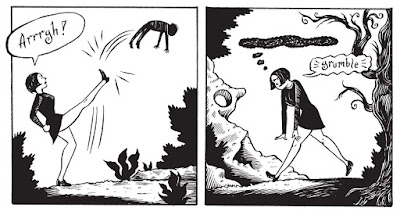 |
| There was a time where Peculia wore shoes... |
She left those shoes behind halfway through her second appearance appearance--in "Evil Eye" #2 (1998)--and she went barefoot everywhere from then on (which was 10 more issues of "Evil Eye", various pin-ups., and "Peculia and the Groon Grove Vampires" (2005).
 |
| ... but, once she left them behind, she never wore shoes again. |
What does this mean? We have no idea, but we further observed that most female characters that appeared in the Peculia stories were barefoot. (The four panels above were excerpted from the first and second stories in the "Peculia" (2002) collection.)
Monday, June 1, 2020
Musical Monday with Shane Filan
Shane Filan is a singer from Ireland who currently holds the distinction of being the Irishman with the most number-one hits on the UK Singles Charts--16 times in total. He comes to Shades of Gray with "Beautiful in White", a very pretty song with an equally pretty video... a celebration of love and weddings, and a very appropriate entry with which to get June started!
Subscribe to:
Posts (Atom)
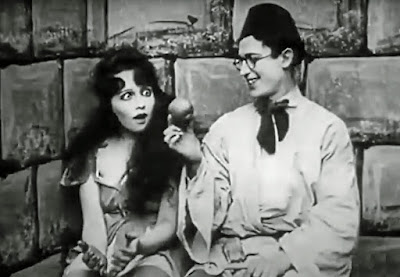
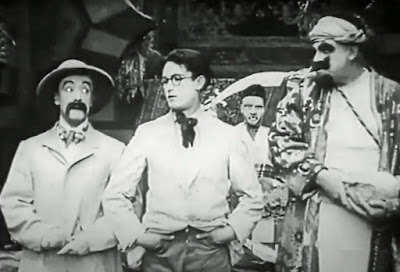

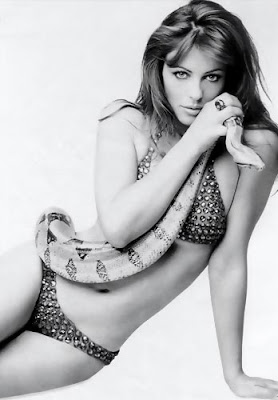
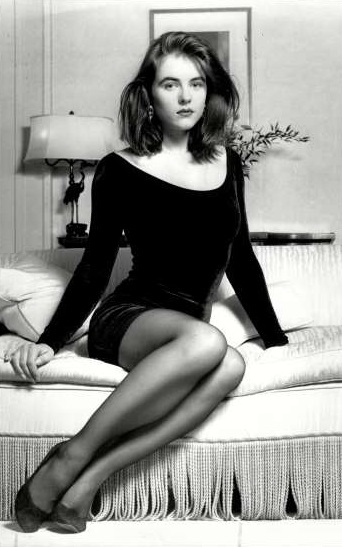



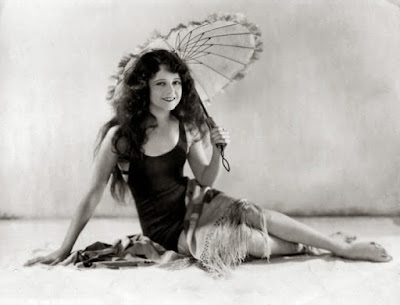
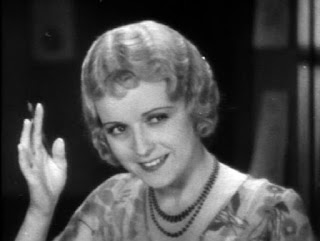














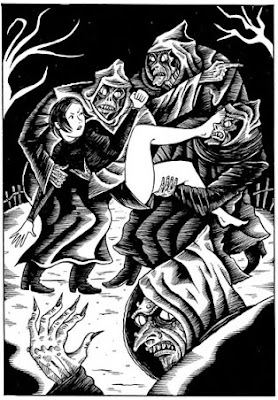
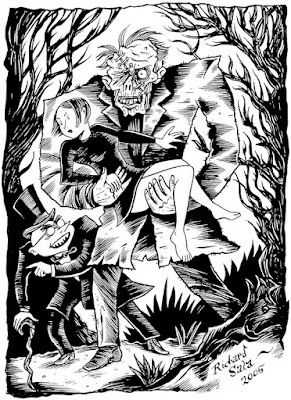













.jpg)






.jpg)
